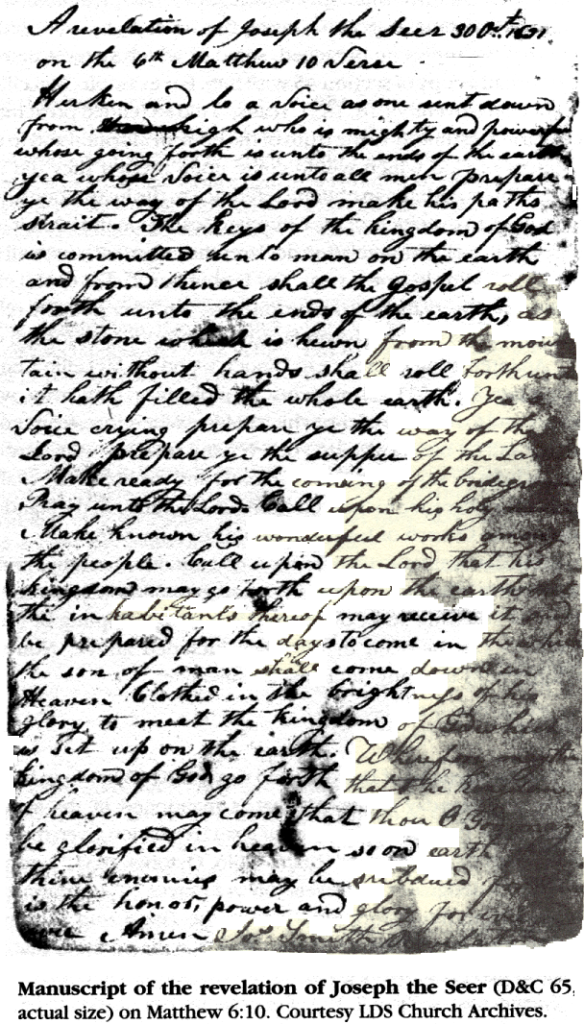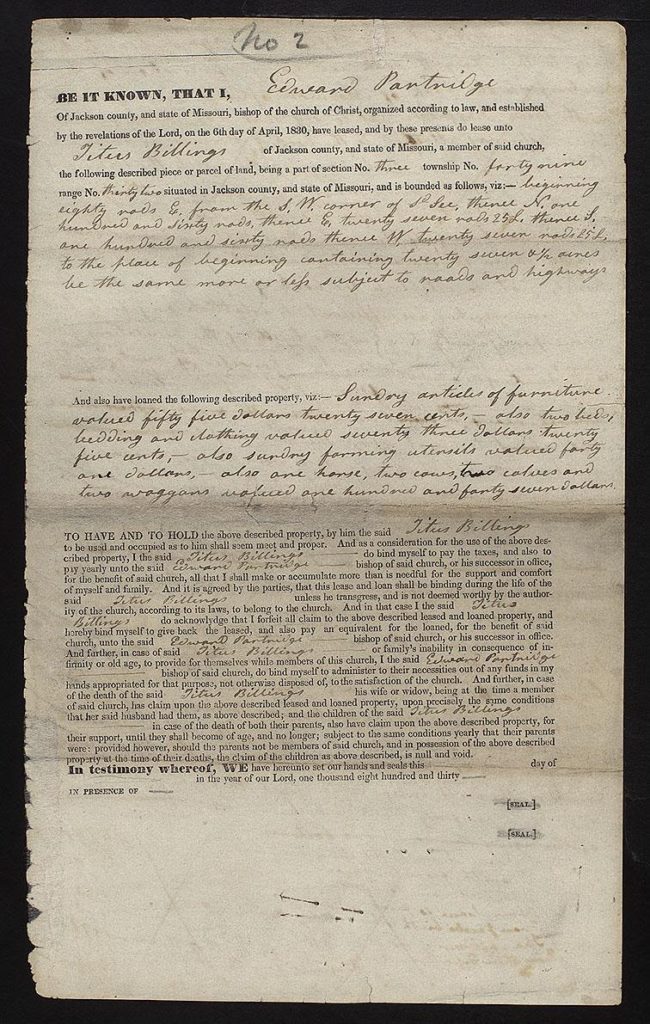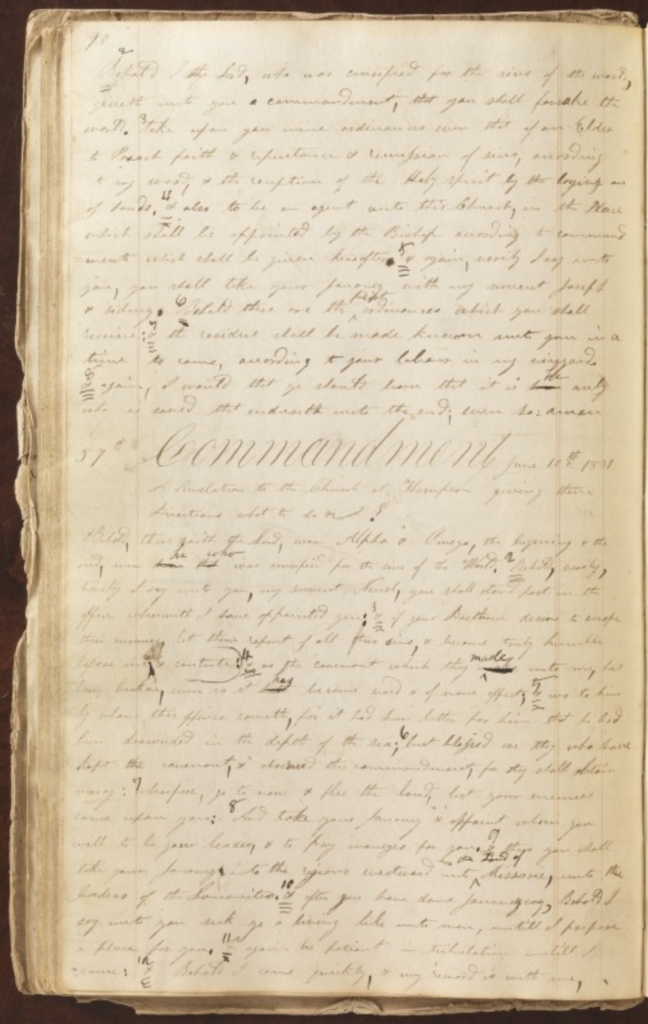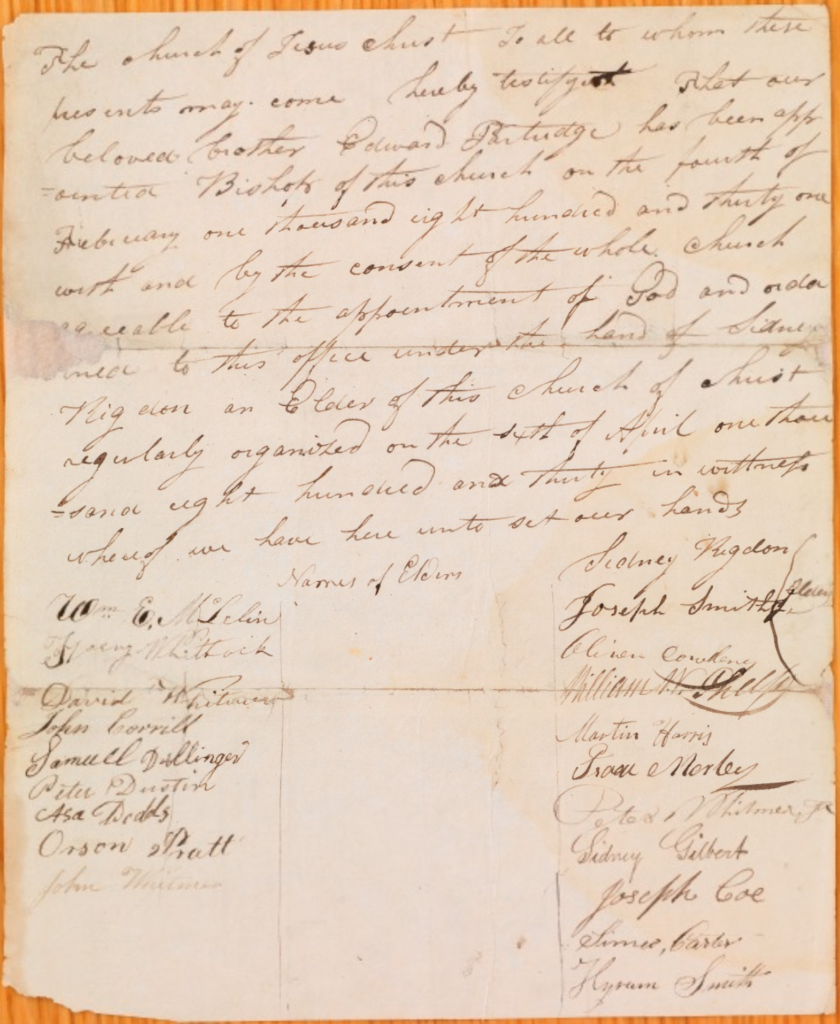Section 64
Various people who observe the same facts interpret the facts differently. The elders’ trip to Missouri in the summer of 1831 led to the dedication of the site for New Jerusalem and the dedication of a temple site. Some returned from the trip rejoicing and others disappointed. The main voice of discontent was Ezra Booth. He noted the outspoken disagreement between Joseph and Edward Partridge about the Missouri land the Lord designated for Zion. Ezra objected that he and Isaac Morley walked to Missouri while Joseph and his party traveled by stage coach. Joseph and Bishop Partridge reconciled. Isaac Morley got over it. Ezra Booth, by contrast, would not let his grievances go.[1] In that setting the Lord gave section 64.[2]
The Lord was angry with Ezra Booth and Isaac Morley. They did not obey section 42 or the commandment they received to preach the gospel en route to Missouri in the summer of 1831 (D&C 52:23).[3] They had unrighteous desires and therefore lost the Holy Ghost. Then, as so often happens, they projected their own evil onto others.The Lord forgave the repentant Isaac Morley while Ezra Booth was disciplined by the church as section 64 directed and withdrew from membership.[4]
The Lord was also upset with Bishop Partridge for arguing with Joseph about the location of Zion (see section 58). He repented in response to section 64. Sidney Gilbert returned to Missouri and established a storehouse there and prepared to buy land for Zion.
Isaac Morley sold his farm as a result of section 64 and thus avoided the overwhelming temptations that the Lord knew would keep him from consecrating otherwise (see section 63:38-40). Frederick Williams consecrated his Kirtland farm to the Church for the Lord to use as a secure headquarters for the church for five more years. Newel Whitney and Sidney Gilbert kept their Kirtland store and other properties for five years after this revelation.
Section 64 paints a vivid picture and makes an unlikely prophecy. It explains with crystal clarity that the saints must leave Babylon or perish, and that the only place other than Babylon is Zion and the only way to get there is by obeying the law of consecration. The Lord’s promise is that the willing and obedient will see Zion. It will come. They will get there. This is the promise which, according to Section 45, holy have been granted in ages past. They longed for Zion and never got there, “but obtained a promise that they should find it and see it in their [resurrected] flesh” (D&C 45:14). Section 64 guarantees Zion tomorrow for those who are willing and obedient to the law of consecration today.
Section 65

Joseph’s history says that section 65 came to him in early October 1831 as he was living with the Johnsons in Hiram, Ohio, and that he regarded it as a prayer.[1] An early copy of section 65 in the handwriting of William McLellin sheds more light on it. The revelation is linked to the Lord’s prayer in Matthew 6, and particularly the meaning of verse 10: “Thy kingdom come. Thy will be done in earth, as it is in heaven.”[2]
Section 65 teaches us to pray for the ideal government. We look for a literal, earthly fulfillment of Isaiah’s declaration: “The Lord is our judge, the Lord is our lawgiver, the Lord is our king; he will save us” (Isaiah 33:22). This short revelation also reminds us how thoroughly biblical Joseph became as he read that sacred text by the light of the Holy Ghost. In the 6 verses of Section 65 there are clear references to Isaiah, Daniel, Matthew, and the Revelation of John.
Section 65 elaborates a prophesy of Daniel, who saw “the God of heaven set up a kingdom, which shall never be destroyed; and the kingdom shall not be left to other people, but it shall break in pieces and consume all these kingdoms, and it shall stand forever”(Daniel 2:44). Daniel compared this kingdom to a rolling stone that would eventually fill the earth. Some of the early saints envisioned a snowball effect, but Joseph clarified Daniel’s meaning. The stone, Joseph said, “is stationary like a grind stone. It revolves.” He taught that it grew as “the Elders went abroad to preach the gospel and the people became believers in the Book of Mormon and were baptized.” In this way “they were added to the little stone. Thus they gathered around it so that it grew larger and larger.” Joseph prophesied that in this way the stone—the kingdom of God—would fill the earth.[3]
In 1838, Judge Austin King charged Joseph Smith with treason and confined him in jail at Liberty, Missouri for believing what he taught about Daniel’s prophecy. Parley Pratt wrote that judge King “inquired diligently into our belief of the seventh chapter of Daniel concerning the kingdom of God, which should subdue all other kingdoms and stand forever.” The saints testified that they believed the prophecy, and judge King instructed his clerk, “write that down; it is a strong point for treason.” The saints’ attorney objected. Is the Bible treason?[4] The next time he was charged with treason came a month after he set up “the kingdom of Daniel by the word of the Lord” and declaring his intent to “revolutionize the whole world.” Joseph life was ended abruptly by a lynch mob shortly after that.[5]
However, the work of God’s kingdom rolled on. It will continue to do so “till it has penetrated every continent, visited every clime, swept every country, and sounded in every ear.”[6] That, at least, is the prayer of section 65. “May the kingdom of God go forth that the Kingdom of Heaven may come”(D&C 65:6), so that he who is entitled may reign as King of Kings (Rev 17:14).
Section 66
Section 66 teaches many lessons. One is to be careful what you ask for. Another is that knowing for certain that Joseph Smith was the Lord’s revelator is insufficient to motivate obedience to the Lord’s revelations through Joseph.
The Lord gave section 66 to William McLellin through Joseph on October 29, 1831. After copying the revelation in his entry for that day, William wrote that it, “gave great joy to my heart because some important questions were answered which had dwelt upon my mind with anxiety and yet with uncertainty.”[1] Previous to meeting Joseph, William secretly prayed that God would “reveal the answer to five questions through his prophet, and that too without his having any knowledge of my having made such request.” In 1848, ten years after bitterly parting ways with Joseph Smith, William wrote: “I now testify in the fear of God, that every question which I had thus lodged in the ears of the Lord of Sabbaoth, were answered to my full and entire satisfaction. I desired it for a testimony of Joseph’s inspiration. And I to this day consider it to me an evidence which I cannot refute.”[2]
William’s questions are unrecorded, but the revelation he wrote as Joseph dictated expresses the Lord’s will for him (66:4). The revelation therefore compelled William to act either in obedience or disobedience to the Lord’s will. His subsequent journal is an accountability report with the revelation in mind. It and related documents reveal his inconsistent effort to obey the revelation’s many specific commands.
The revelation blessed William for turning from his iniquities to truth and receiving the fulness of the gospel. Still, the Lord told William that he was not completely clean and needed to repent of sins the Lord would show him. The Lord specifically warned William to “commit not adultery—a temptation with which thou hast been troubled” (D&C 66:10). The Lord commanded William to serve a mission to the east with Samuel Smith until the Lord sent word for them to return. The Lord commanded William to bear testimony to everyone everywhere he went, and his journal testifies that he did. He went about “reasoning with the people” while Samuel Smith bore his simple, powerful testimony as a witness of the Book of Mormon plates. Commanded to “lay your hands upon the sick and they shall recover,” William did so and they were. He tried to “be patient in affliction,” but as rejections mounted and winter approached, William’s resolve to obey the revelation faltered (D&C 66:9). He forsook Samuel Smith and returned to Kirtland in late December 1831 of his own volition. The Lord rebuked William a few weeks later (D&C 75:6-7).
Humbled, William started on another mission but again forsook his companion and calling, attributing his disobedience to poor health and lack of faith. He took a job to accumulate cash and married Emiline Miller, perhaps in disobedience to the command “seek not to be cumbered” (D&C 66:10) with family obligations while called to fulltime missionary service. Then the newlyweds set out for Zion in Jackson County, Missouri, where William circumvented the law of consecration. Rather than meeting with Bishop Partridge to consecrate his property and receive an inheritance, William purchased two lots on Main Street, all in disobedience to specific commands that he “go not up to the land of Zion as yet; but inasmuch as you can send, send; otherwise think not of thy property” (66:6).
William’s disobedience to the revelation did not diminish his faith in it or its revelator. He wrote in August 1832 that “that Joseph Smith is a true Prophet or Seer of the Lord and that he has power and does receive revelations from God, and that these revelations when received are of divine Authority in the church of Christ.”[3] Upset by William’s hypocrisy, Joseph wrote that his “conduct merits the disapprobation of every true follower of Christ.“[4]
Section 66 left William’s future in his hands. If he chose to do the Lord’s will continually, he could “have a crown of eternal life” (66:12). Instead William chose to do his own will. On 11 May 1838, William confessed to Bishop Partridge that he had quit “praying and keeping the commandments of God and went his own way and indulged himself in his lustful desires.”[5] He spent the rest of his long life outside the Savior’s church, struggling to resolve the unbearable tension between his sure testimony of the revelation and his unwillingness to abide by all of its terms.
Section 64 notes
[1] See “Historical Introduction” to “Revelation, 11 September 1831 [D&C 64],” p. 108, The Joseph Smith Papers, accessed October 5, 2020, https://www.josephsmithpapers.org/paper-summary/revelation-11-september-1831-dc-64/1.
[2] “Revelation, 11 September 1831 [D&C 64],” p. 108, The Joseph Smith Papers, accessed October 5, 2020, https://www.josephsmithpapers.org/paper-summary/revelation-11-september-1831-dc-64/1.
[3] Ezra Booth, “Mormonism—No. V,” Ohio Star 10 November 1831, p. 3.
[4] “Minute Book 2,” p. 6, The Joseph Smith Papers, accessed October 5, 2020, https://www.josephsmithpapers.org/paper-summary/minute-book-2/8.
Section 65 notes
[1] “History, 1838–1856, volume A-1 [23 December 1805–30 August 1834],” p. 155, The Joseph Smith Papers, accessed October 5, 2020, https://www.josephsmithpapers.org/paper-summary/history-1838-1856-volume-a-1-23-december-1805-30-august-1834/161.
[2] See The Journals of William E. McLellin, 243.
[3] Henry William Bigler (1815–1900), Journal, 1846 Feb.–1899 Oct., Church History Library, Salt Lake City.
[4] Parley P. Pratt, Jr., editor, The Autobiography of Parley Parker Pratt 4th edition (Salt Lake City: Deseret, 1950), 211-12.
[5] Andrew F. Ehat, “‘It Seems Like Heaven Began on Earth’: Joseph Smith and the Constitution of the Kingdom of God,” BYU Studies 20:3 (Spring 1980), 253-79.
[6] “History, 1838–1856, volume C-1 [2 November 1838–31 July 1842],” p. 1285, The Joseph Smith Papers, accessed October 5, 2020, https://www.josephsmithpapers.org/paper-summary/history-1838-1856-volume-c-1-2-november-1838-31-july-1842/459.
Section 66 notes
[1] Jan Shipps and John W. Welch, editors, The Journals of William E. McLellin, 1831-1836 (Urbana: University of Illinois Press, 1994), 46-47.
[2] Jan Shipps and John W. Welch, editors, The Journals of William E. McLellin, 1831-1836 (Urbana: University of Illinois Press, 1994), 57.
[3] Jan Shipps and John W. Welch, editors, The Journals of William E. McLellin, 1831-1836 (Urbana: University of Illinois Press, 1994), 87.
[4] “Letter to Emma Smith, 6 June 1832,” p. [2], The Joseph Smith Papers, accessed October 5, 2020, https://www.josephsmithpapers.org/paper-summary/letter-to-emma-smith-6-june-1832/2.
[5] “History, 1838–1856, volume B-1 [1 September 1834–2 November 1838],” p. 796, The Joseph Smith Papers, accessed October 5, 2020, https://www.josephsmithpapers.org/paper-summary/history-1838-1856-volume-b-1-1-september-1834-2-november-1838/250.

 He also counseled the bishop to apply Section 51 by deeding pieces of land to saints as their “individual property.” Joseph called this “private stewardship,” not ownership. Bishop Partridge issued several such deeds based on Section 51. (See Titus Billings example.) When Section 51 was first published in 1835, much of verse 5 was added to keep folks like Bates from suing the Lord’s bishop. Joseph wrote to Bishop Partridge that the revelation in D&C 51:5 was given so “that rich men cannot have power to disinherit the poor by obtaining again that which they have consecrated.”
He also counseled the bishop to apply Section 51 by deeding pieces of land to saints as their “individual property.” Joseph called this “private stewardship,” not ownership. Bishop Partridge issued several such deeds based on Section 51. (See Titus Billings example.) When Section 51 was first published in 1835, much of verse 5 was added to keep folks like Bates from suing the Lord’s bishop. Joseph wrote to Bishop Partridge that the revelation in D&C 51:5 was given so “that rich men cannot have power to disinherit the poor by obtaining again that which they have consecrated.”

